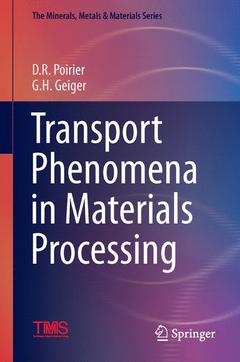Transport Phenomena in Materials Processing, 1st ed. 2016 The Minerals, Metals & Materials Series
Coordonnateurs : Poirier David R., Geiger G.

CHAPTER 1: VISCOUS PROPERTIES OF FLUIDS.
1.1 Types of fluid flow.
1.2 Newtonian fluids.
1.3 Viscosity of gases.
1.4 Viscosity of liquids.
1.5 Non-Newtonian fluids.
CHAPTER 2: LAMINAR FLOW AND THE MOMENTUM EQUATION.
2.1 Momentum balance.
2.2 Flow of a falling film.
2.3 Fully developed flow between parallel plates.
2.4 Fully developed flow through a circular tube.
2.5 Equation of continuity and the momentum equation.
2.6 The momentum equation in rectangular and curvilinear coordinates.
2.7 Application of Navier-Stokes" equation.
CHAPTER 3: TURBULENT FLOW AND COMPLEX FLOWS.
3.1 Friction factors for flow in tubes.
3.2 Flow in noncircular conduits.
3.3 Flow past submerged bodies.
3.4 Flow through porous media.
3.5 Fluidized beds.
CHAPTER 4: ENERGY BALANCE APPLICATIONS IN FLUID FLOW.
4.1 Conservation of energy.
4.2 Friction losses in straight conduits.
4.3 Enlargement and contraction.
4.4 Flow through valves and fittings.
4.5 Flow through smooth bends and coils.
4.6 Flow measurement.
4.7 Flow from ladles.
4.8 Flow through piping networks.
CHAPTER 5: FLOW AND VACUUM PRODUCTION.
5.1 Pumps.
5.2 Fans and blowers.
5.3 Interactions between fans or pumps and systems.
5.4 Supersonic nozzles and jet behavior.
5.5 Vacuum production.
PART II: ENERGY TRANSPORT.
CHAPTER 6: FOURIER"S LAW AND THERMAL CONDUCTIVITY OF MATERIALS.
6.1 Fourier"s law and thermal conductivity.
6.2 Thermal conductivity of gases.
6.3 Thermal conductivity of solids.
6.4 Thermal conductivity of liquids.
6.5 Thermal conductivity of bulk materials.
CHAPTER 7: HEAT TRANSFER AND THE ENERGY EQUATION.
7.1 Heat transfer with forced convection in a tube.
7.2 Heat transfer with laminar forced convection over a flat plate.
7.3 Heat transfer with natural convection.
7.4 Heat conduction.
7.5 The general energy equation.
7.6 The energy equation in rectangular and curvilinear coordinates.
CHAPTER 8: CORRELATIONS AND DATA FOR HEAT TRANSFER COEFFICIENTS.
8.1 Heat transfer coefficients for forced convection in tubes.
8.2 Heat transfer coefficients for forced convection past submerged objects.
8.3 Heat transfer coefficients for natural convection.
8.4 Quenching heat transfer coefficients.
8.5 Heat transfer coefficients in fluidized beds.
8.6 Heat transfer coefficients in packed beds.
8.7 Heat transfer coefficients in forging.
CHAPTER 9: CONDUCTION OF HEAT IN SOLIDS.
9.1 The energy equation for conduction.
9.2 Steady-state one-dimensional systems.
9.3 Transient systems finite dimensions.
9.4 Transient conditions in finite and semi-infinite solids.
9.5 Simple multidimensional problems.
9.6 Moving sources.
CHAPTER 10: SOLIDIFICATION OF METALS.
10.1 Solidification in sand molds.
10.2 Solidification in metal molds.
10.3 Continuous casting.
10.4 Crystal growth.
CHAPTER 11: RADIATION HEAT TRANSFER.
11.1 Basic characteristics.
11.2 The black radiator and emissivity.
11.3 The energy distribution and the emissive power.
11.4 Gray bodies and absorptivity.
11.5 Exchange between infinite parallel...
Date de parution : 12-2016
Ouvrage de 660 p.
15.2x22.9 cm



